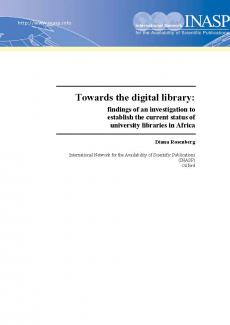
Towards the digital library in Africa
Download publication files
In 2004 INASP commissioned a survey of the current status of digital libraries in sub-Saharan Anglophone Africa.
The report examines the progress that has been made by university libraries in Africa in introducing electronic systems and services and suggests where developments and investments might now be made to further advance the implementation of digital libraries. Although the survey data is confined to sub-Saharan Anglophone Africa (not South Africa), it is hoped that many of the results are also relevant to other African countries and the developing world in general. The term digital library is used to refer to a library where some or all of the holdings are available in electronic form, and the services of the library are also made available electronically frequently over the Internet.
One conclusion is that university libraries in Africa are at very different stages of digital development, with very different needs. Programmes that assume that all libraries within a region or country have the same needs and aspirations are unlikely to be successful. It is important to recognise that a library must also have the basic building blocks of a digital library in place before it can move forward into providing electronic services. Training of library staff remains key, but there is a call for training methods to be diversified and a new emphasis is placed on ensuring that the curricula and teaching in library schools has kept pace with the new digital environment. User education remains a challenge. Finally, librarians say that they lack advice as to where to go next. Mechanisms for sharing in-country experiences or driving forward digital developments are not widely available.
